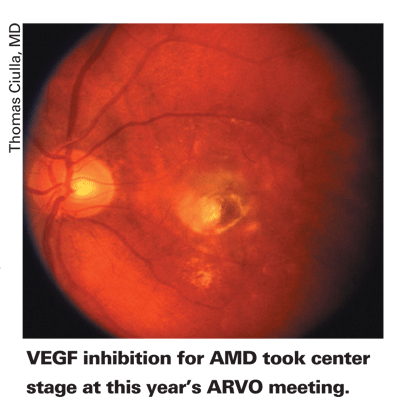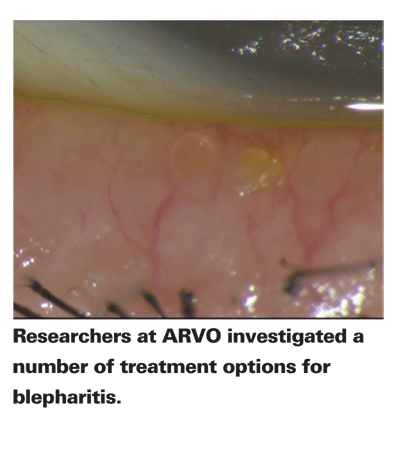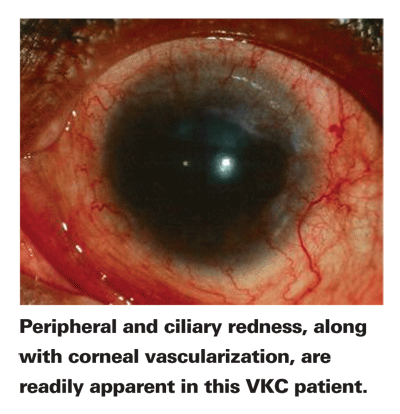Mark B. Abelson, MD; Donna Welch, RN, BSN; James McLaughlin; Russell Anderson; Lauren Lilyestrom; and Ava Taylor, North Andover, Mass.
Age-related diseases are among the most common causes of blindness. The theme of the 2007 Association for Research in Vision and Ophthalmology meeting was "the aging eye," and thousands of researchers presented their work in hopes of shedding light on age-related macular degeneration, glaucoma and other ocular conditions. Of course, interesting and groundbreaking research was also presented in areas other than the aging eye, including dry eye and allergy. Although it's impossible to completely assimilate the vast amount of research presented at ARVO 2007, the following is a summary of the highlights.
Age-related Macular Degeneration
Here is a look at treatments for this devastating disease, some already approved and others that are on the way:
• Current treatments. Two anti-VEGF agents remain in the forefront of neovascular AMD treatment: the monoclonal antibody bevacizumab (Avastin, Genentech) and its fragment ranibizumab (Lucentis, Genentech). Although Lucentis' efficacy for wet AMD was famously demonstrated in two Phase III studies, ANCHOR and
In a long-term, retrospective study of monthly intravitreal bevacizumab in patients with wet AMD, researchers found mean retinal thickness significantly decreased, and mean visual acuity significantly increased after three and six months (Castellarin AA, et al. IOVS 2007;48: ARVO E-Abstract 75). A prospective case series of intravitreal bevacizumab in retinopathy of prematurity observed neovascular regression in all (27/27) patients after a mean of six months follow-up (Martinez-Castellanos MA, et al. IOVS 2007;48: ARVO E-Abstract 85). A retrospective study of intravitreal bevacizumab in branch retinal vein occlusion (n=36) found that nine eyes remained within three lines of baseline visual acuity, and 27 eyes improved two or more lines (Roca JA, et al. IOVS 2007;48: ARVO E-Abstract 91).
• Treatments in development. Interim Phase II data on VEGF-Trap, a potent fusion-protein anti-VEGF agent, was presented (Benz MS, et al. IOVS 2007;48: ARVO E-Abstract 4549). At the 12-week endpoint, intravitreal VEGF-Trap significantly reduced retinal thickness by an average of 135 µm, as measured by optical coherence tomography posterior pole scan, and significantly improved visual acuity an average of 5.9 letters across the five treatment arms. At eight and 12 weeks, monthly and quarterly dosing schedules did not have significantly different outcomes.
Some research shows that complementary mechanisms may make anti-VEGFs useful adjuncts to photodynamic therapy. PDT can seal neovascular membranes, but PDT also stimulates inflammation and VEGF release. These disadvantages may be mitigated by anti-VEGFs, which bind VEGF and reduce inflammation. After chart review of 20 patients who received PDT and an anti-VEGF agent, patients who received PDT first were more likely (75 percent) to improve in acuity compared to patients receiving anti-VEGFs first (33 percent) (Adams SG, et al. IOVS 2007;48: ARVO E-Abstract 4542). VERITAS, a randomized, double-masked multicenter trial, is currently investigating combination PDT and anti-VEGF therapy for wet AMD (
Although the acronym VEGF contains the word "vascular," the protein may also be neuroprotective.1 Under hypoxic stress, VEGF receptors are increasingly expressed on the surface of neuronal cells. Neuropathologists have found that binding to these neuronal receptors triggers a series of anti-apoptotic and neuroprotective effects.2 Ophthalmologists are noticing similar effects in the retina (Adamis AP, et al. IOVS 2007;48: ARVO E-Abstract 615). Intravitreal VEGF-A reduced neuronal apoptosis in a dose-dependent manner after ischemic injury in two rat models, demonstrating that VEGF-A is an adaptive neuroprotective response during retinal ischemia. Potent anti-VEGFs, such as bevacizumab and ranibizumab, which reduce VEGF concentration, may therefore be neurotoxic. However, two other studies found no conclusive evidence of anti-VEGF neurotoxicity in the rat (Yanagi Y, et al. IOVS 2007;48: ARVO E-Abstract 36) or monkey retina (Cousins SW, et al. IOVS 2007;48: ARVO E-Abstract 22).
Several ARVO researchers proposed ways of inhibiting ocular angiogenesis without directly binding VEGF. The bioactive lysolipid sphingosine 1-phosphate (S1P) may mediate pro-angiogenic signaling. Shingozumab, a monoclonal antibody that binds to S1P, inhibited choroidal neovascularization lesion formation 98.5 percent by volume compared to vehicle when intravitreally injected in a laser-induced CNV mouse model (Stoller G, et al. 2007;48: ARVO E-Abstract 1967). In the chick chorioallantoic membrane model, the effect of pro-angiogenic stimulators was significantly inhibited by the antioxidant OT-551/OT-674 (Mousa SA, et al. IOVS 2007;48: ARVO E-Abstract 3424).

The fibronectin receptor a5b1 integrin plays an essential role in the angiogenic cascade as an interface with the extracellular matrix. JSM6427, an a5b1 inhibitor, slowed fluorescein leakage after four weeks when intravitreally injected into two models of CNV: a laser-induced monkey model and a VEGF/bFGF pellet rabbit model (Zhan G, et al. IOVS 2007;48: ARVO E-Abstract 3430). JAK2 is a signaling kinase that acts downstream from erythropoietin, a glycoprotein hormone, which, along with VEGF, is involved in the pathogenesis of diabetic retinopathy. The VEGF receptor and JAK2 inhibitor TG101095 dosed topically b.i.d. for two weeks significantly reduced CNV area in a laser-induced CNV mouse model, suggesting efficacy for both diabetic retinopathy and AMD (Chen ZZ, et al. IOVS 2007;48: ARVO E-Abstract 1469). Researchers also evaluated a series of receptor tyrosine kinase inhibitors (RTKi), including Alcon's AL-39324, Novartis' PTK787, and Pfizer's Sutent and CP-547,632 (Bingaman DP, et al. IOVS 2007;48: ARVO E-Abstract 1747). Of the RTKis, AL-39324 reduced CNV lesion size most effectively, doing so in 70.6 percent of treated subjects compared to controls when intravitreally injected in a mouse model. Although data on these drug candidates is preliminary, the diversity of therapeutic targets in the wet AMD drug pipeline bodes well for the future.
Glaucoma
Researchers are also studying the efficacy of our current glaucoma treatments, as well as novel therapies:
• Current treatment. Intraocular pressure variation was a strong predictor of progressive visual field loss in the Collaborative Initial Glaucoma Treatment Study (CIGTS) (
• Treatments in development. At its highest concentration, K-115, a novel rho-kinase inhibitor, lowered IOP 4.4 ±0.3 mmHg after two hours, which was a greater effect than latanoprost (Xalatan, Pfizer) (2.5 ±0.2 mmHg, p<0.01) in a rabbit model (Mizuno K, et al. IOVS 2007;48: ARVO E-Abstract 4805). A siRNA drug candidate screening study found that several compounds that inhibit the genes rennin, cochlin, selectin E (ELAM) and 11-beta-hydroxysteroid dehydrogenase-2 (11-b HSD) reduced IOP in a manner comparable to latanoprost (Peral A, et al. IOVS 2007;48: ARVO E-Abstract 4808).
No neuroprotective agent is approved in the
Dry Eye and Blepharitis
External disease was also highlighted in several ARVO sessions. Here are the papers that caught our attention:
• Characteristics and diagnosis. A topic of considerable interest at ARVO in the realm of dry eye was lid margin environment. One team presented results from their attempt to develop methods for differentiating chronic blepharitis from dry eye. They looked at 41 dry-eye sufferers and 19 patients with chronic blepharitis. Meibomian gland dysfunction, determined by gland dropout, was common among the dry-eye patients (Tomlinson A, et al. IOVS 2007;48: ARVO E-Abstract 412), although some researchers suggest this is only one of a variety of factors that can indicate MGD. MGD is believed to be impacted by sex hormone levels; accordingly, a study which examined gland physiology through women's menstrual cycles found that gland orifices were smallest just after ovulation. Though it focused on a small population, this study also promoted a promising new method of meibum collection, utilizing a small adhesive strip from which secretions can be dissolved and analyzed (Suzuki T, et al. IOVS 2007;48: ARVO E-Abstract 412). The sex-dependent characteristics of meibomian gland dysfunction were also examined in mice. The mRNA of aromatase, which aromatizes androgens to form estrogens, has been located in human meibomian glands. In wild-type mice, meibomian gland aromatase was found to upregulate more than 500 genes; in knockout mice, it upregulates more than 260 genes. Most of the genes regulated by aromatase were sex-specific (Liu S, et al. IOVS 2007;48: ARVO E-Abstract 5657). Another clinical correlation—this one between increasing age and decreasing lid margin health—was noted by another study performed by our group. We examined a variety of factors, including gland alignment, lid hyperkeratinization and vascularity, and secretion color (Workman DA, et al. IOVS 2007;48: ARVO E-Abstract 406).
The interaction between meibomian lipids and the tear film may be more complicated than first thought. Researchers presented surprising results suggesting that meibomian lipids may in fact destabilize the tear film and increase aqueous evaporation. One explanation is that when properly balanced, the lipid layer does retard evaporation; however the imbalance resulting from unhealthy meibomian secretions may be counterproductive to tear-film stability. There was a correlation between tear-film protein levels and slower tear evaporation, meaning that anti-evaporative qualities may be achieved through proper interaction of the outer lipid layer and subphase proteins (Millar TJ, et al. IOVS 2007;48: ARVO E-Abstract 431).
• Treatments in development. Tea tree oil was studied by a number of researchers for its ability to eradicate demodex infestations in the lid environment. Excessive demodex, a member of the natural lid-margin flora, may contribute to blepharitis and dry-eye symptoms. It was found that terpinen-4-01 makes up approximately 30 percent of tea tree oil, and it is believed to be the source of the oil's antimicrobial properties (Merritt JJ, et al. IOVS 2007;48: ARVO E-Abstract 771).
Researchers evaluated systemic doxycycline for its effects on the signs, symptoms, conjunctival cytology and expression of conjunctival ICAM-1 in patients with chronic blepharitis (n=8). Two weeks of b.i.d. dosing with 100 mg systemic doxycycline yielded improvements in signs and symptoms of blepharitis, while also appearing to downregulate MMP-9 expression (Iovieno A, et al. IOVS 2007;48: ARVO E-Abstract 367). Topical doxycycline was also tested, and its positive effects correlated between two dry-eye models: the pre-clinical murine model and the established controlled adverse environment clinical model (Crampton A, et al. IOVS 2007;48: ARVO E-Abstract 402).
Finally, one group presented fascinating research on lacritin, the naturally occurring prosecretory mitogen responsible for the regulation of the mucin MUC16. HCTE-T cells treated either with lacritin or with lacritin N-deletion constructs were used for proliferation assays, and real-time PCR was used to monitor MUC16 mRNA. Results suggested that two lacritin sites are required for HCE-T cell proliferation. Since alternative splicing is possible for both, dry eye may be characterized by certain splice forms. Additionally, the researchers found that since MUC16 mRNA is unchanged, MUC16 is regulated post-transcriptionally by lacritin (Laurie GW, et al. IOVS 2007;48: ARVO E-Abstract 2726).
• Visual function. Our group, Ophthalmic Research Associates, coordinated a Special Interest Group meeting that focused on the differences between the central and peripheral corneas, and presented data showing a significant correlation between central corneal staining and decreased visual function between blinks.
Researchers presented a poster that explained a new method for measuring inter-blink interval visual acuity decay (Walker P, et al. IOVS 2007;48: ARVO E-Abstract 422); another poster demonstrated a significant difference between normals and dry-eye patients using this test (Ousler GW, et al. IOVS 2007;48: ARVO E-Abstract 410). The rapid TFBUT of dry eye is thought to contribute to a quicker drop in vision between blinks.
Blink rate and tear dynamics can also be modified by visual tasks, and one study looked specifically at the potential for near tasks to impact tear-film breakup. Investigators found that even a short 20-minute video gaming session yielded significant changes in breakup time and dry-eye symptoms in the dry-eye population. Area breakup time in both dry eye and control patients increased significantly after five seconds, and in dry-eye patients the final area breakup time also significantly increased. Some changes were also observed in the control population, reaffirming dry eye as an acute condition as well as a disease (Bedroya M, et al. IOVS 2007;48: ARVO E-Abstract 417).
Allergy
Researchers investigated the evergreen topics of allergy therapies and mechanisms this year. Here are some of their more important findings:
• Current therapies. Research on current therapies for ocular allergy focused on further exploring their safety and efficacy. Investigators performed a retrospective analysis of data from studies involving olopatadine 0.1% (Patanol, Alcon), olopatadine 0.2% (Pataday, Alcon), ketotifen 0.25% (Zaditor, Novartis), azelastine 0.05% (Optivar, MedPointe) and epinastine 0.05% (Elestat, Allergan) to evaluate the incidence of ocular dryness in subjects using topical antihistamines. They found the incidence of dry eye in subjects receiving an anti-allergic medication to be less than or equal to that of placebo (Krokhmal L, et al. IOVS 2007;48: ARVO E-Abstract 2300). Researchers studied levocabastine to further elucidate the mechanism behind its activity. It appears that levocabastine may also act as an 4b1 integrin antagonist, blocking the infiltration of eosinophils into the conjunctiva during the allergic reaction (Bucolo C, et al. IOVS 2007;48: ARVO E-Abstract 2307).
The conjunctival allergen challenge (CAC) is a standard study design for the evaluation of ophthalmic anti-allergy medications, and uses a skin prick to determine preliminary subject eligibility. Investigators undertook a retrospective analysis of two CAC studies (n=302) to evaluate the predictive value of skin tests for ocular allergy. More severe skin test reactions were found to have particularly high predictive value for both subject enrollment and ocular sensitivity to allergen (Chaturvedi R, et al. IOVS 2007;48: ARVO E-Abstract 2297).
• Mechanisms. Although the general mechanism for the allergic cascade is well-understood, the search for a deeper understanding and development of therapeutic targets continues. One study reported on the expression of the FceRI receptor on conjunctival dendritic cells. Researchers performed double immunohistochemical staining with conjugated antibodies against the FceRI receptor and the dendritic cell tissue marker CD1. They found that vernal keratoconjunctivitis subjects had significantly fewer double positive cells than did non-atopic subjects. This phenotype is therefore upregulated in patients with VKC. Dendritic cells express the receptor for IgE on their surfaces, which enhances antigen presentation when dendritic cells are present in higher numbers, thereby increasing their ability to prime T-cells (Manzouri B, et al. IOVS 2007;48: ARVO E-Abstract 2318).
Another study looked into the role of chemokine receptor 3 in allergic conjunctivitis. The CCR3 antagonist W-56750 significantly suppressed allergen-induced late phase inflammatory responses, including the recruitment of eosinophils, neutrophils and mast cells. The treatment also decreased clinical symptoms, vascular permeability and mast cell degranulation (Komatsu N, et al. IOVS 2007;48: ARVO E-Abstract 2319).
However, the development of new therapies is often fraught with difficulties. Mice deficient in CCR1, which is known to be expressed on mast cells, neutrophils and eosinophils, weren't expected to show a full allergic reaction. However, little difference was noticed between the allergic response of the knockout mice and wild-type mice, and eosinophil counts were actually higher in the knockout mice (Ikeda Y, et al. IOVS 2007;48: ARVO E-Abstract 2299). The search for new drug targets is complicated by such mechanisms. Still, inflammatory mediators play a key role in the development of the signs and symptoms of allergic conjunctivitis.
Infection
Many bacteria exist in symbiosis with humans, and often stave off infections through their interactions with other flora. Some have suggested the concept of quorum-sensing as a means by which usually non-pathogenic bacteria become virulent. Quorum sensing involves bacteria recognizing other bacteria, and changing their behavior based on their concentration. Thresholds at which bacteria become virulent are variable, and the exact mechanisms of quorum-sensing are unkown. An Australian group that developed a modified suppression subtractive hybridization PCR method is looking to help solve this riddle.

Using this method, they compared the genes of virulent and avirulent strains of P. aeruginosa. One of the genes they cataloged is lasI, which is known as a regulator of quorum-sensing (Zhu H, et al. IOVS 2007;48: ARVO E-Abstract 2658). Abnormalities in the expression of such genes could be related to the development of infection.
Inflammation
Since bacterial infections are generally accompanied by inflammation, the combination of an antibiotic with a steroid is desirable. In addition, the ocular bioavailability of antibiotics in the corneal epithelium is limited by the presence of active P-glycoprotein, and steroids inhibit P-gp. One study examined the ocular bioavailability of erythromycin in the rabbit corneal epithelium when combined with methyl prednisolone or prednisolone and prednisone. The antibiotic-steroid combinations increased the ocular bioavailability of erythromycin, with Cmax and Clast being about five and three times higher, respectively, for the erythromycin/methyl prednisolone combination when compared to control (Cmax refers to the maximum concentration of erythromycin in the aqueous humor; Clast is the concentration of erythromycin at the last time point). The erythromycin/prednisolone-prednisone combination displayed pharmacokinetic parameters that were over two times higher than control (Hariharan S, et al. IOVS 2007;48: ARVO E-Abstract 4321).
Another study looked at the effects of thymosin b4 on the adhesion of polymorphonuclear leukocytes to endothelium and on cytokine production after stimulation by TNF-a. After TNF-a stimulation, expression of IL-18 and IL-1 was significantly decreased by thymosin b4. PMN adhesion to human umbilical vein endothelial cells was inhibited by thymosin b4 membrane ICAM-1 levels were also decreased. Thymosin b4 is therefore expected to have clinical efficacy for the treatment of corneal inflammation (Sosne G, et al. IOVS 2007;48: ARVO E-Abstract 3649).
Despite the hurdles ophthalmic research often faces, continuing advancements are being made. We look forward to seeing what this coming year will bring.
Dr. Abelson, an associate clinical professor of ophthalmology at
1. Sun FY, Guo X. Molecular and cellular mechanisms of neuroprotection by vascular endothelial growth factor. J Neurosci Res 2005;791-2:180-4.
2. Gora-Kupilas K, Josko J. The neuroprotective function of vascular endothelial growth factor (VEGF). Folia Neuropathol 2005;43:1:31-9.



